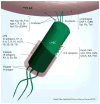Preventing urinary tract infection: progress toward an effective Escherichia coli vaccine
- PMID: 22873125
- PMCID: PMC3498450
- DOI: 10.1586/erv.12.36
Preventing urinary tract infection: progress toward an effective Escherichia coli vaccine
Abstract
Uncomplicated urinary tract infections (UTIs) are common, with nearly half of all women experiencing at least one UTI in their lifetime. This high frequency of infection results in huge annual economic costs, decreased workforce productivity and high patient morbidity. At least 80% of these infections are caused by uropathogenic Escherichia coli (UPEC). UPEC can reside side by side with commensal strains in the gastrointestinal tract and gain access to the bladder via colonization of the urethra. Antibiotics represent the current standard treatment for UTI; however, even after treatment, patients frequently suffer from recurrent infection with the same or different strains. In addition, successful long-term treatment has been complicated by a rise in both the number of antibiotic-resistant strains and the prevalence of antibiotic-resistance mechanisms. As a result, preventative approaches to UTI, such as vaccination, have been sought. This review summarizes recent advances in UPEC vaccine development and outlines future directions for the field.
Figures


References
-
- Foxman B. The epidemiology of urinary tract infection. Nat Rev Urol. 2010;7(12):653–660. A recent review on the epidemiology of urinary tract infections (UTIs) - PubMed
-
- Foxman B, Brown P. Epidemiology of urinary tract infections: transmission and risk factors, incidence, and costs. Infect Dis Clin North Am. 2003;17(2):227–241. - PubMed
-
- Foxman B, Gillespie B, Koopman J, et al. Risk factors for second urinary tract infection among college women. Am J Epidemiol. 2000;151(12):1194–1205. - PubMed
-
- DeFrances CJ, Lucas CA, Buie VC, Golosinskiy A. 2006 National Hospital Discharge Survey. Natl Health Stat Report. 2008;5:1–20. - PubMed
-
- Litwin MS, Saigal CS, Yano EM, et al. Urologic Diseases in America Project. Urologic diseases in America Project: analytical methods and principal findings. J Urol. 2005;173(3):933–937. - PubMed
Website
-
- Medimmune, Inc. [Accessed on 6 June 2012];Annual Report. 2002 www.astrazeneca.com/Investors/Annual-reports.
Publication types
MeSH terms
Substances
Grants and funding
LinkOut - more resources
Full Text Sources
Other Literature Sources
Medical
Research Materials
